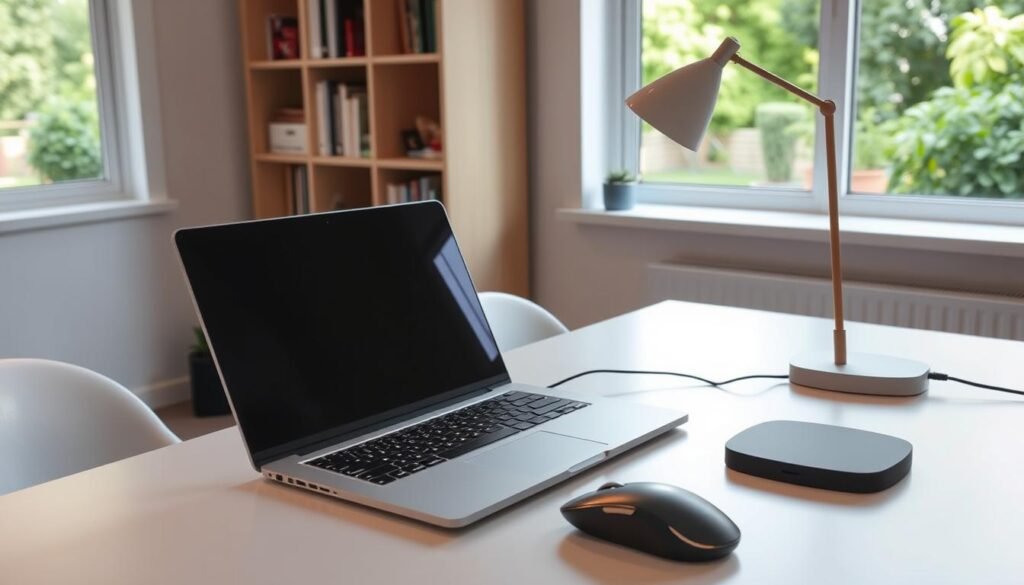Starting a blog can seem like a daunting task, but it doesn’t have to be. With basic computer skills, you can create a blog in no time. According to Scott Chow, a well-known blogging expert, “Starting a blog can seem intimidating, but with the most basic computer skills, you can create a blog in 20 minutes.”
Launching a successful blog requires some guidance, but with the right tips, it can be a straightforward process. In this article, we’ll cover the essential tips for beginner bloggers to help you get started on your blogging journey.
Key Takeaways
- Learn how to start a blog quickly and easily
- Understand the basics of blogging for beginners
- Discover essential tips for launching a successful blog
- Get familiar with the necessary tools for blogging
- Find out how to make your blog stand out
Understanding the Blogging Landscape
As a beginner blogger, understanding the blogging landscape is crucial for success in the ever-evolving online world. The blogging sphere is constantly changing, with new trends and technologies emerging regularly.
Why Start a Blog in 2025?
Starting a blog in 2025 can be a great decision for those looking to share their passion or expertise with a wider audience. With the rise of online content, blogging remains a powerful medium for self-expression and connection. According to Syed Balkhi, founder of WPBeginner, there are valuable lessons to be learned from experienced bloggers.
Setting Realistic Expectations for New Bloggers
New bloggers should be aware that success doesn’t happen overnight. It takes time to build an audience and gain traction. Setting realistic expectations is key to avoiding disappointment and staying motivated.
The Commitment: Time and Resources Needed
Blogging requires a significant commitment of both time and resources. Regularly creating high-quality content, managing your blog’s technical aspects, and engaging with your audience are essential tasks. Understanding the time and resources needed will help you prepare for the journey ahead.
Finding Your Blogging Niche and Voice
The first step to a successful blog is finding a niche that resonates with your passion and expertise. This crucial step lays the foundation for a blog that attracts and retains a dedicated audience.
How to Identify Your Unique Blogging Niche
To identify your niche, start by exploring your interests and areas of expertise. Consider what you’re passionate about and what you can discuss extensively without needing to research every detail. Your niche should be a balance between what you love and what has an audience.

Researching Audience Needs in Your Chosen Niche
Once you have a niche in mind, research your target audience’s needs. Understand their pain points, questions, and interests. This step is crucial for creating content that resonates with your readers and keeps them coming back.
Developing an Authentic Blogging Voice
Your blogging voice is what sets you apart from others in your niche. It’s about being authentic and consistent in your tone and language. Be yourself, and let your personality shine through your writing to build a loyal following.
By focusing on these key areas, you can establish a strong foundation for your blog, making it more likely to succeed in the competitive blogging world.
Choosing the Right Blogging Platform
Selecting the ideal blogging platform is a crucial step for new bloggers. With so many options available, it’s essential to understand the pros and cons of each to make an informed decision.
WordPress vs. Other Popular Platforms
WordPress is often considered the gold standard for blogging platforms due to its flexibility and customization options. Other popular platforms like Blogger and Medium offer simplicity and ease of use, but may lack the advanced features that WordPress provides. When choosing a platform, consider your needs for customization, SEO, and integration with social media.
Comparison of Popular Blogging Platforms
| Platform | Customization | SEO Capabilities | Ease of Use |
|---|---|---|---|
| WordPress | High | Excellent | Moderate |
| Blogger | Moderate | Good | Easy |
| Medium | Low | Good | Easy |
Free vs. Self-Hosted Options: Pros and Cons
Free blogging platforms like Blogger and WordPress.com offer a convenient starting point, but they come with limitations, such as restricted customization and monetization options. Self-hosted options, particularly WordPress.org, provide more control and flexibility but require a financial investment in hosting and a domain name.
Platform Features That Matter for Beginners
For beginners, key features to look for in a blogging platform include ease of use, available themes and customization options, SEO tools, and customer support. WordPress stands out for its extensive plugin library and community support, making it an ideal choice for those willing to invest time in learning its capabilities.
When starting a blog, it’s crucial to consider your long-term goals and how your chosen platform will support your growth. By understanding the strengths and weaknesses of different platforms, you can make a more informed decision that aligns with your blogging aspirations.
Essential Technical Setup for Beginner Blogging
The journey to establishing a successful blog begins with the right technical setup. To get your blog up and running, you need three fundamental elements: domain registration, blog hosting, and blogging software. Understanding these components is crucial for a smooth start.
Domain Name Selection and Registration
Your domain name is your blog’s identity on the internet. It should be memorable, easy to spell, and relevant to your content. When selecting a domain name, consider using keywords that reflect your blog’s niche. Once you’ve chosen a name, register it through a reputable registrar like GoDaddy or Namecheap. Registration typically costs between $10 to $15 per year.
Web Hosting Basics for New Bloggers
Web hosting is where your blog’s files are stored. For beginners, it’s essential to choose a reliable hosting service that offers good customer support. Popular options include Bluehost, SiteGround, and HostGator. When selecting a hosting plan, consider factors like storage space, bandwidth, and scalability. Many hosts offer beginner-friendly plans that include a free domain name and SSL certificate.

Installing and Setting Up Your Blog
Most hosting services offer a 1-click installation process for popular blogging platforms like WordPress. Once installed, you’ll need to configure basic settings, such as setting your blog’s title, timezone, and permalink structure. Familiarize yourself with the dashboard to manage posts, pages, and comments effectively.
Essential Plugins and Tools to Start With
Plugins extend the functionality of your blog. For beginners, essential plugins include security tools like Wordfence, SEO optimization plugins like Yoast SEO, and performance enhancers like WP Rocket. Start with a few must-have plugins and gradually add more as you become more comfortable with managing your blog.
| Plugin/Tool | Purpose | Benefit |
|---|---|---|
| Wordfence | Security | Protects against malware and unauthorized access |
| Yoast SEO | SEO Optimization | Improves search engine rankings with keyword analysis |
| WP Rocket | Performance | Enhances page load speed and overall performance |
By focusing on these technical aspects, new bloggers can establish a solid foundation for their blog, ensuring a smooth and successful blogging journey.
Designing Your Blog for Reader Engagement
Effective blog design is about more than just aesthetics; it’s about creating a seamless user experience that captivates your audience from the start. A well-designed blog can significantly enhance reader engagement, encouraging visitors to explore your content further.
Choosing the Right Theme and Layout
Selecting a theme that resonates with your blog’s niche is crucial. According to WordPress, “One of the great things about WordPress is that you can change your entire layout and design with just a few clicks.” This flexibility allows you to experiment with different themes until you find the one that best represents your brand.
When choosing a theme, consider the layout and how it will impact your content’s readability. A cluttered layout can deter readers, while a clean and simple design can enhance their experience.
Essential Pages Every Blog Should Have
Certain pages are essential for a fully functional blog. These include:
- About Page: Introduces you to your readers.
- Contact Page: Allows readers to get in touch with you.
- Privacy Policy: Informs readers about how you handle their data.
Mobile Optimization Fundamentals
With the majority of internet users accessing content via mobile devices, ensuring your blog is mobile-friendly is paramount. A responsive design adapts to different screen sizes, providing an optimal reading experience across devices.
User Experience Considerations for Beginners
For a beginner blogger, focusing on user experience (UX) can make a significant difference. Key UX considerations include:
| UX Element | Description |
|---|---|
| Navigation | Easy-to-use menus and clear categorization. |
| Loading Speed | Fast loading times to prevent reader bounce. |
| Content Readability | Clear fonts and appropriate font sizes. |
By focusing on these aspects, you can create a blog that not only looks great but also provides a superior reading experience, thereby enhancing reader engagement.
Creating Compelling Content That Resonates
The heart of any successful blog lies in its ability to create content that truly resonates with its readers. As a beginner blogger, understanding the elements of compelling content is crucial for engaging your audience and setting your blog up for success.
Content Planning and Editorial Calendars
Effective content planning is the foundation of a successful blogging strategy. An editorial calendar helps you organize your content in advance, ensuring consistency and reducing the stress of coming up with new ideas at the last minute. By planning your content, you can align your posts with your overall blogging goals and audience needs.
To create an editorial calendar, start by identifying key themes and topics relevant to your niche. Then, decide on the frequency of your posts and schedule them accordingly. Tools like Google Calendar, Trello, or Asana can be invaluable in managing your content schedule.
Writing Engaging Headlines and Introductions
Your headline is often the first thing a reader sees, making it crucial for capturing their attention. Craft headlines that are informative, yet enticing. Your introduction should then draw the reader in, providing a clear direction for the rest of the post.
To write engaging headlines, focus on creating a sense of urgency or curiosity. Use action verbs and questions that resonate with your audience’s needs or interests. For introductions, start with a hook that grabs the reader’s attention, followed by a brief overview of what to expect from the post.

Incorporating Images and Media Effectively
Images and media can significantly enhance the appeal of your blog posts, making them more engaging and shareable. When incorporating images, ensure they are relevant to your content and of high quality.
Use images to break up text, illustrate complex points, or add visual interest. Consider the copyright status of images and use royalty-free or licensed images. Media such as videos or podcasts can also be integrated to provide a richer experience for your readers.
Finding Your Content Creation Rhythm
Consistency is key to maintaining a successful blog. Finding a content creation rhythm that works for you is essential for long-term success. Experiment with different schedules and formats to find what suits your style and audience best.
As “Writing a blog post is not as easy as I used to consider it,” it requires a lot of hard work, dedication, research, and commitment. By establishing a routine and sticking to it, you can develop a loyal readership and continuously improve your content.
SEO Fundamentals for Beginner Bloggers
For new bloggers, mastering SEO basics can significantly enhance their content’s reach. SEO, or Search Engine Optimization, is a crucial aspect of blogging that helps your content rank higher in search engine results, making it more visible to your target audience.
Keyword Research for Beginners
Keyword research is the foundation of SEO. It involves identifying the words and phrases your target audience uses to search for content like yours. Tools like Google Keyword Planner and Ahrefs can help you find relevant keywords. Focus on long-tail keywords that are less competitive and more specific to your niche.
On-Page SEO Best Practices
On-page SEO refers to the practices you can implement directly on your blog to improve its search engine ranking. This includes optimizing your title tags, meta descriptions, and headings. Ensure your content is well-structured and includes relevant keywords naturally.
Understanding Search Intent for Better Content
Understanding search intent is about creating content that matches what users are looking for. It’s not just about using the right keywords, but also about providing value to your readers. Analyze the top-ranking content for your target keywords to understand what search engines consider relevant.
Tracking and Analyzing Your Blog’s Performance
To understand how your SEO efforts are performing, you need to track your blog’s performance. Tools like Google Analytics can provide insights into your traffic, engagement, and conversion rates. Regularly reviewing these metrics can help you refine your SEO strategy.
| SEO Aspect | Importance | Action |
|---|---|---|
| Keyword Research | High | Use tools like Google Keyword Planner |
| On-Page SEO | High | Optimize title tags, meta descriptions |
| Understanding Search Intent | Medium | Analyze top-ranking content |
| Tracking Performance | High | Use Google Analytics |
By focusing on these SEO fundamentals, beginner bloggers can lay a strong foundation for their blog’s success, improving visibility and attracting more readers.
Growing Your Blog’s Audience and Community
Growing your blog’s audience requires a strategic approach to social media, email marketing, and engagement. As a beginner blogger, it’s essential to understand that building a loyal community around your blog takes time and effort, but it’s worth it.

Social Media Strategies for New Bloggers
Social media is a powerful tool for promoting your blog and engaging with your audience. To get started, focus on the platforms where your target audience is most active. For example, if you’re targeting a younger demographic, Instagram and TikTok might be more effective than Facebook. Share your blog posts, behind-the-scenes content, and interact with your followers to build a loyal community.
Building an Email List from Day One
Building an email list is crucial for maintaining a direct line of communication with your audience. Offer incentives such as free e-books, webinars, or exclusive content to encourage visitors to subscribe to your newsletter. Use email marketing tools like Mailchimp or ConvertKit to manage your list and create engaging campaigns.
Networking with Other Bloggers
Networking with other bloggers in your niche can help you reach a broader audience. Participate in blogging communities, attend webinars, and collaborate with fellow bloggers on content projects. Guest blogging is another effective way to build backlinks to your site and attract new readers.
Engaging with Comments and Feedback
Engaging with your readers is vital for building a loyal community. Respond to comments on your blog and social media channels, and encourage feedback by asking questions or requesting suggestions. This interaction not only builds trust but also provides valuable insights into your audience’s needs and preferences.
By implementing these strategies, beginner bloggers can effectively grow their audience and build a thriving community around their blog. Remember, consistency and engagement are key to long-term success in the blogging world.
Conclusion: Your Blogging Journey Begins Now
Starting a blog can seem daunting, but with the right guidance, you can launch your blogging journey in no time. As discussed, the key to successful blogging lies in understanding your niche, choosing the right platform, and creating compelling content that resonates with your audience.
For those starting a blog for beginners, it’s essential to begin with a solid foundation. This beginner blogger guide has provided you with the essential tips to get started. From selecting a domain name to optimizing your blog for search engines, you’ve learned the crucial steps to establish a strong online presence.
Now, it’s time to put these blogging101 principles into action. With a little creativity and persistence, you can create a blog that attracts and engages your target audience. So, just how do you start a blog? By following the steps outlined in this guide, you can learn how to create a blog in about 20 minutes and start sharing your ideas with the world.
FAQ
What is the best way to start a blog for beginners?
How do I choose a profitable blogging niche?
What are the differences between free and self-hosted blogging platforms?
How important is SEO for beginner bloggers?
What are the essential technical setup requirements for blogging?
How can I grow my blog’s audience and community?
What type of content should I create for my blog?
How often should I post new content on my blog?
Can I start a blog without prior writing experience?
How do I monetize my blog?
Prabir Dutta
Prabir Dutta is a passionate digital creator, affiliate marketer, and wellness enthusiast who simplifies complex topics like AI tools, Vastu, pet care, and modern living. With a keen eye for SEO, tech trends, and everyday health solutions, he writes to empower readers with actionable, smart-living insights. When not curating content across his network of niche blogs, Prabir enjoys exploring new digital tools that make life easier and more efficient.






